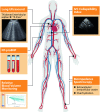Assessment and management of fluid overload in children on dialysis
- PMID: 29523958
- PMCID: PMC6311194
- DOI: 10.1007/s00467-018-3916-4
Assessment and management of fluid overload in children on dialysis
Abstract
Dysregulation of intravascular fluid leads to chronic volume overload in children with end-stage kidney disease (ESKD). Sequelae include left ventricular hypertrophy and remodeling and impaired cardiac function. As a result, cardiovascular complications are the commonest cause of mortality in the pediatric dialysis population. The clinical need to optimize intravascular volume in children with ESKD is clear; however, its assessment and management is the most challenging aspect of the pediatric dialysis prescription. Minimizing chronic fluid overload is a key priority; however, excessive ultrafiltration is toxic to the myocardium and can precipitate intradialytic symptoms. This review outlines emerging objective techniques to enhance the assessment of fluid overload in children on dialysis and outlines evidence for current management strategies to address this clinical problem.
Keywords: Children; Dialysis; Fluid balance; Hypertension; Ultrasonography.
Conflict of interest statement
The authors declare that they have no conflict of interest.
Figures
Similar articles
-
Setting the dry weight and its cardiovascular implications.Semin Dial. 2017 Nov;30(6):481-488. doi: 10.1111/sdi.12624. Epub 2017 Jun 30. Semin Dial. 2017. PMID: 28666069 Free PMC article. Review.
-
Interplay of volume, blood pressure, organ ischemia, residual renal function, and diet: certainties and uncertainties with dialytic management.Semin Dial. 2017 Sep;30(5):420-429. doi: 10.1111/sdi.12612. Epub 2017 Jun 5. Semin Dial. 2017. PMID: 28581677 Review.
-
Effect of fluid management guided by bioimpedance spectroscopy on cardiovascular parameters in hemodialysis patients: a randomized controlled trial.Am J Kidney Dis. 2013 Jun;61(6):957-65. doi: 10.1053/j.ajkd.2012.12.017. Epub 2013 Feb 15. Am J Kidney Dis. 2013. PMID: 23415416 Clinical Trial.
-
Management of fluid overload in hemodialysis patients.Kidney Int. 2021 Dec;100(6):1170-1173. doi: 10.1016/j.kint.2021.09.013. Kidney Int. 2021. PMID: 34802558
-
Heart Failure in End-Stage Kidney Disease: Pathophysiology, Diagnosis, and Therapeutic Strategies.Semin Nephrol. 2018 Nov;38(6):600-617. doi: 10.1016/j.semnephrol.2018.08.005. Semin Nephrol. 2018. PMID: 30413254 Review.
Cited by
-
Nutritional Assessment and Management in Paediatric Chronic Kidney Disease.J Nutr Metab. 2021 Oct 12;2021:8283471. doi: 10.1155/2021/8283471. eCollection 2021. J Nutr Metab. 2021. PMID: 34676115 Free PMC article. Review.
-
Nutritional status and volume control in adolescents on chronic hemodialysis.Pediatr Nephrol. 2021 Nov;36(11):3733-3740. doi: 10.1007/s00467-021-05089-6. Epub 2021 May 14. Pediatr Nephrol. 2021. PMID: 33988730
-
Monitoring dialysis adequacy: history and current practice.Pediatr Nephrol. 2021 Aug;36(8):2265-2277. doi: 10.1007/s00467-020-04816-9. Epub 2021 Jan 5. Pediatr Nephrol. 2021. PMID: 33399992
-
Assessment of fluid status in neonatal dialysis: the need for new tools.Pediatr Nephrol. 2023 Apr;38(4):1373-1379. doi: 10.1007/s00467-022-05829-2. Epub 2022 Dec 2. Pediatr Nephrol. 2023. PMID: 36459242 Free PMC article.
-
Bedside sonographic assessments for predicting predialysis fluid overload in children with end-stage kidney disease.Eur J Pediatr. 2021 Oct;180(10):3191-3200. doi: 10.1007/s00431-021-04086-z. Epub 2021 Apr 30. Eur J Pediatr. 2021. PMID: 33928452
References
-
- Bakkaloglu SA, Kandur Y, Serdaroglu E, Noyan A, Bayazit AK, Sever L, Ozlu SG, Ozcelik G, Dursun I, Alparslan C (2017) Effect of the timing of dialysis initiation on left ventricular hypertrophy and inflammation in pediatric patients. Pediatr Nephrol. 10.1007/s00467-017-3660-1 - PubMed
Publication types
MeSH terms
LinkOut - more resources
Full Text Sources
Other Literature Sources
Medical
Research Materials



